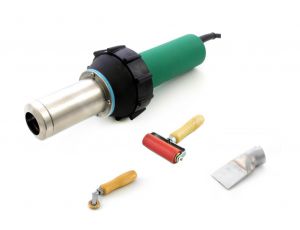Roofing Membrane Welding Machines
How does a welding machine work? It is a device that heats the air to temperatures above 400 degrees and melts the foil, which allows you to press and connect both materials. The pressure force and temperature depend on the type of material and the conditions in which we work. The welding speed of the working person should be taken into account. Which welding machine to choose? The choice is not complicated. If you want to weld a small piece, tear or crack, you can use the AT-4500 model, but for serious work it will be too weak equipment, then use BOSITE-D or BOSITE D+. These are hand-held devices that you can use to do all the work on the roof, such as folds around fire walls, canopies, bay windows, skylights and air conditioning ducts. Of course, for large works, where you will be putting the roofing foil from the beginning, the obligatory equipment is the BOSITE ROOF or BOSITE 7001 machine for the largest tasks. How is the roof membrane welded? In the case of manual welding machines, you put a flat nozzle between the surfaces and press it with a silicone or Teflon roller to obtain a 4-5 cm weld; with a larger machine, it is even simpler because it basically comes down to inserting the nozzle and checking whether the weld is simply performed. Preparation of the roof - substrate and membrane for welding. The roof should have an even ground, i.e. either concrete, or with wool or polystyrene insulation, which often make the fall immediately. With eps or xps, between the membrane you put interlining, i.e. a glass fiber mat that protects against the temperature during welding and allows subsequent minor movements of the surface. For a few hours, and preferably 24 hours before welding, unfold the membrane to straighten it, only now you can pin it before, because the material will expand and you will not get an even surface. You make the overlap for 10-12 cm, but the weld itself is 4 cm if it is an automatic 4-5 cm if you do it manually. Unfortunately, all machining is the longest process, because you do everything yourself without the intervention of the machine. What are the types of insulation films and several manufacturers? Roof insulation films are divided into two types currently used in Poland, the most commonly used are PVC membranes, such as Protan or Bauder, and a new generation already available in Poland (Alphadam) and used in Germany for 10 years. It is a modified EPDM ie TPO or FPO having a much longer service life; even lighter and, thanks to greater flexibility, more durable and, most importantly, easier to install and weld. There are also liquid acrylic membranes and membranes based on other bases on the market. Unfortunately, it is a technology in which there are a lot of errors when laying and the water just stands on the surface.











